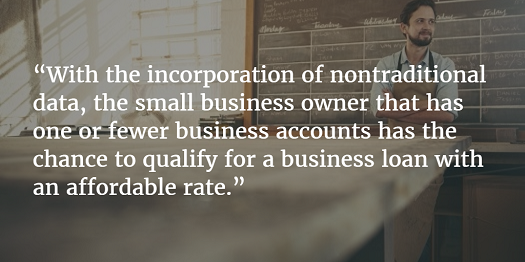The American economy rises and falls on the successes of the small business community. As a major contributor to job growth, as well as innovation, small businesses have laid the foundation toward our country’s economic success. But as important as small businesses are to financial progress of our economy, some business owners have experienced their own growth challenges along the way.
Perhaps the most significant challenge has been the inability to access financial capital. In the years since the economic downturn, conventional lending sources, such as banks and credit unions, have tightened their lending criteria.
Many small businesses, especially those with a limited credit history, have had difficulty demonstrating their creditworthiness and are deemed as high risk. Without access to financial capital, small businesses are not able to order new inventory, hire new employees, react to emergencies or expand their businesses.
But what if financial institutions did not just leverage traditional credit information to determine a business’s ability to repay a loan, but also took nontraditional data sources into consideration? For instance, what if banks and credit unions leveraged data on daily sales, accounting information, Web traffic, business valuation or even social media data?
The benefits of this scenario could be endless. Not only will many small businesses have a better opportunity to qualify for business loans, but a whole new segment of the small business owner population will be able to obtain financing, namely the new business start-up. With the incorporation of nontraditional data, the small business owner that has one or fewer business accounts has the chance to qualify for a business loan with an affordable rate.
In fact, there are a number of online marketplace lenders, or nonbank lenders, that have already begun taking this nontraditional approach. These companies leverage a wealth of data points, such as social media or Web traffic, to help fill the void that a business with limited credit history might have. By combining both traditional and nontraditional data sets, these lenders are able to help small businesses access financial resources, while expanding their own portfolios.
For example, consider a beauty salon that has been opened for less than a year, but constantly has customers filling up its chairs and enjoys sufficient cash flow. If we look at its credit history, there may be two small tradelines with positive payment behavior. However, despite the positive performance, its business credit score is relatively low. Under normal circumstances, the salon would have trouble securing a business loan.
But, if its social media presence were taken into consideration, the salon could be viewed as the burgeoning business that it is. Combine the hundreds of positive reviews and social media references with its strong cash flow; it could signal that the salon is a growing business with potentially low risk of defaulting on an approved loan.
Clearly, without the benefit of this added information, this small business would not be able to access the financial resources to expand. The insights that can be uncovered by utilizing nontraditional data sources can open new doors for small businesses. Additionally, given the opportunity, small businesses can take our economy to new heights, which is good for local communities, our country and society as a whole.
***
Eric Haller is the executive vice president of Experian’s DataLabs and Hiq is the president of Experian’s Business Information Services.
